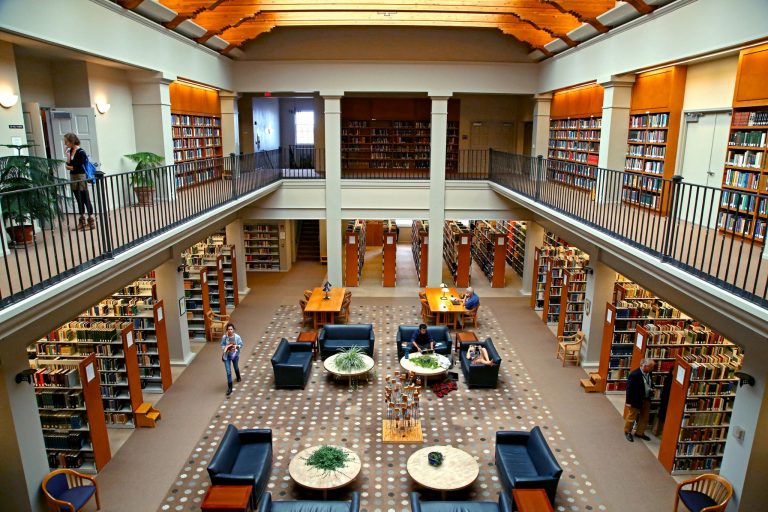
Before starting your college education, it would be wise to consider these questions: do you want a flexible program of study? Do you want the freedom to choose subjects from a variety of fields? Do you want a well-rounded education that prepares you for work across different industries? If so, a liberal arts college in the United States may be a perfect fit for you.
But what is a liberal arts college? You hear it mentioned a lot, but not many are familiar with how it actually works. So a short lesson in history may be necessary. The origins of the liberal arts are well-established and fascinating, dating back to ancient Greece and Rome. In those city-states, a liberal arts education was considered essential for free citizens, consisting of grammar, rhetoric, and logic – skills thought to be indispensable for participation in public life.

Image courtesy of Le Moyne College
Over centuries, the liberal arts education has evolved to include subjects like arithmetic, geometry, and astronomy. Eventually, it arrived on the shores of America, where it still thrives today in small colleges and even some large universities. Like its Greek and Roman forms, the liberal arts in America originally sought to cultivate civic participation, and above all, leadership. As Eugene M. Lang writes, “Liberal arts colleges—like many other colleges and universities—have their philosophical roots in a tradition that began in New England over three hundred years ago.”
Liberal arts colleges today still retain the basic structure of this system – students choose and learn from large range of subjects in the arts, humanities, social sciences, natural sciences, and mathematics. Think of it as a buffet approach to education. Students are not required to declare their major (or concentration) until their second or third year, allowing them to experiment and settle on what they want to do in life.
“Students don’t have to choose a career focus right away—they have time to explore,” Laine Phillipa, former Director of International Education at a U.S. university, told The Independent.
“The courses may introduce them to many topics they have not learned about before. These courses broaden perspective and could lead them to a totally new career focus.”

Image courtesy of St. John’s College
This greatly contrasts with the UK university system, which typically requires students to declare their concentration upon admission. In that sense, the UK system is far more goal-based (you know where you’re headed and you study towards it), and the U.S. system is far more experiential (you learn a bit of everything and that equips you with diverse skills for life). It’s essentially a destination versus journey dynamic.
And this emphasis on experiential learning is evident in liberal arts colleges throughout the U.S. Students are highly encouraged to participate in class discussions and debates, receiving points for their overall grade when they do. Liberal arts colleges are typically small and residential, providing a close-knit atmosphere where collaborative and mentorship activities are commonplace. They also feature smaller class sizes and lower student-teacher ratios, allowing for quality interaction between faculty and students. All this results in an optimal environment for academic learning as well as personal growth.

Image courtesy of Le Moyne College
But it’s not just in the classroom where the liberal arts effect can be felt. In the modern workplace, employers are on the lookout for graduates who not only have a great degree but who can hit the ground running. A liberal arts education helps equip students with a broad range of skills (both hard and soft) and encourages an adaptive nature, which is invaluable in a dynamic work environment.
If all that sounds great to you, then you should consider studying in the U.S. – a country that pretty much invented the modern-day liberal arts curriculum. It should come as no surprise that America still boasts the best liberal arts colleges anywhere in the world, and here are just a few:
ST. JOHN’S COLLEGE – ANNAPOLIS, MARYLAND & SANTA FE, NEW MEXICO
Founded in 1696, St. John’s College is the third-oldest college in the United States – one reason why it receives such respect across the country. The college has two picturesque campuses – one in Annapolis, Maryland, and another in Santa Fe, New Mexico.
St. John’s features an interdisciplinary common curriculum (all students learn literature, philosophy, math, science, and more) – boasting one of the truest liberal arts educations in the country. The college is well-regarded for its Great Books Program, by which students survey Western civilization through 100 classic works.
All classes are small, hosting 20 or fewer students, making for an intimate and effective learning environment. The student community is diverse – 15 percent are international students drawn from over 27 countries. The college boasts impressive graduate outcomes, with almost 70 percent of graduates pursuing advanced degrees — many enter the nation’s leading humanities, science, business, law, and medical programs.
LE MOYNE COLLEGE – SYRACUSE, NEW YORK
Offering a rigorous world class educational experience, Le Moyne College is ranked by The Princeton Review and U.S. News & World Report as one of the nation’s best institutions. Values-based education in the Jesuit tradition fosters intellectual excellence and preparation for a life of leadership and service.
Students have the opportunity to study with world renowned faculty who are authors, philosophers, advisors to the United States government and military forces, on international boards of manufacturers, and practitioners in their fields who bring real world case studies to the classroom. Undergraduate programs include business, technology, math, and science and the traditional liberal arts. Graduate programs include an MBA and degrees in information systems, occupational therapy, education, arts administration, nursing, and physician assistant studies.
Le Moyne is host to 2,500 undergraduate and 800 graduate students. Its campus is located in Syracuse, an affordable city at the heart of New York State within a five hour bus or train ride to Niagara Falls, New York City, Boston, Philadelphia, Washington, D.C., and Toronto, Canada.

Image courtesy of Lafayette College / Tomwsulcer
LAFAYETTE COLLEGE – EASTON, PENNSYLVANIA
Established in 1826, Lafayette College overlooks the scenic Delaware River in Easton, Pennsylvania. The college’s mission statement is to nurture the inquiring mind and to integrate intellectual, social, and personal growth among all students. To that end, it offers a Bachelor of Arts in 37 fields and a Bachelor of Science in 14 fields, including four in Engineering. The college maintains an enviable student-faculty ratio of 10.5 to 1, encouraging close-knit collaboration and mentorship. Lafayette boats a strong, proud tradition of community service – 79 percent of students have participated in community service by the time they are seniors.
EARLHAM COLLEGE – RICHMOND, INDIANA
Earlham College is a national liberal arts college with renowned international appeal – U.S. News and World Report ranked Earlham at No. 6 nationally for its percentage (18 percent) of international students on campus. The college’s international student community is drawn from nearly 80 different countries. Earlham offers more than 40 courses of study, taught in small classes with plenty of opportunities for discussion and investigation. The college encourages students to take charge of their own learning, while investing in efforts to change the world for the better. Earlham graduates have been admitted into prestigious institutions like Harvard University, Columbia University, and the University of Oxford.
SMITH COLLEGE – NORTHAMPTON, MASSACHUSETTS
Founded in 1871, Smith College is one of the prestigious and famous liberal arts colleges in the U.S. It is one of the largest women’s colleges in the country, hosting students from 48 states and 68 different countries. Smith offers 1,000 courses in over 50 areas of study, and features an outstanding student-faculty ratio of 9:1. Smith graduates can look forward to great success in the working world, since 91 percent of Smith graduates in the labor market find work within two years of graduating. Smith alumnae consist of many luminaries and famous individuals, including Sylvia Plath, Julia Child, Gloria Steinem, Nancy Reagan, and Barbara Bush.
Feature image courtesy of the St. John’s College
Liked this? Then you’ll love these…
Colleges that change lives – the value of a Liberal Arts degree
Career success and a fulfilling student experience through the liberal arts











